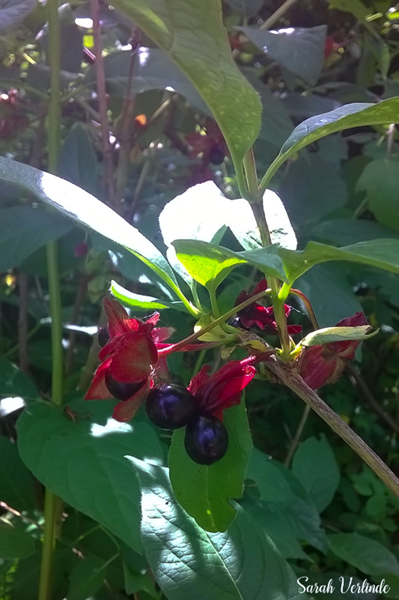Black Twinberry
Lonicera involucrata – Black twinberry
At a Glance:

- Family: Caprifoliaceae
- Plant Type: Deciduous erect shrub
- Distribution: Primarily western North America, as far east as Montana, and the Great Lakes area.
- Habitat: woods and wetland areas, near streambanks, and sandy coastal areas, low elevations
- Height: up to 12 feet tall
- Flower/Fruits: Pair of yellow bell flowers with a brown-red bract below it. Named for the pair of black berries that form opposite each other.
- Flowering Season: April – August
- Leaves: oblong-elliptic up to 14cm long, smooth on the upper side of the leaf, with coarse hairs on the underside.
- Generation: Perennial
- Bark: newer stems can be a natural pale brown or smooth green, and quadrangular (four sides like a mint). Mature bark is gray-brown and peeling/shredding in places.
- Notable feature: One of the few shrubs in the PNW that are oppositely arranged
Restoration and Conservation
The tubular shaped flowers provide an important nectar source for hummingbirds, butterflies, and moths. The berries are eaten by birds, small mammals, and bears. In restoration applications, Twinberry is a great shrub to plant along shorelines and help stabilize stream banks.
Ethnobotany
The berries may be poisonous and at the very least considered inedible. The plant was used in a variety of ways by Native Americans by using the leaves, berries, or bark as poultices or tea for various ailments. The Quileute and Kwakwaka’wakw tribes used the berries for a black pigment, and the Haida used them for a black hair dye.
References and Resources
- Pojar, J and MacKinnon, A. 2004. Plants of the Pacific Northwest Coast: Washington, Oregon, British Columbia and Alaska. Vancouver (BC): Lone Pine Publishing.
- USDA: https://plants.usda.gov/factsheet/pdf/fs_loin5.pdf
- WTU Image Herbarium: http://biology.burke.washington.edu/herbarium/imagecollection/taxon.php?Taxon=Lonicera%20involucrata
This article was written by Sarah Verlinde. For questions regarding the UWB/CC Plant Tour, contact Sarah at severlin@uw.edu.
